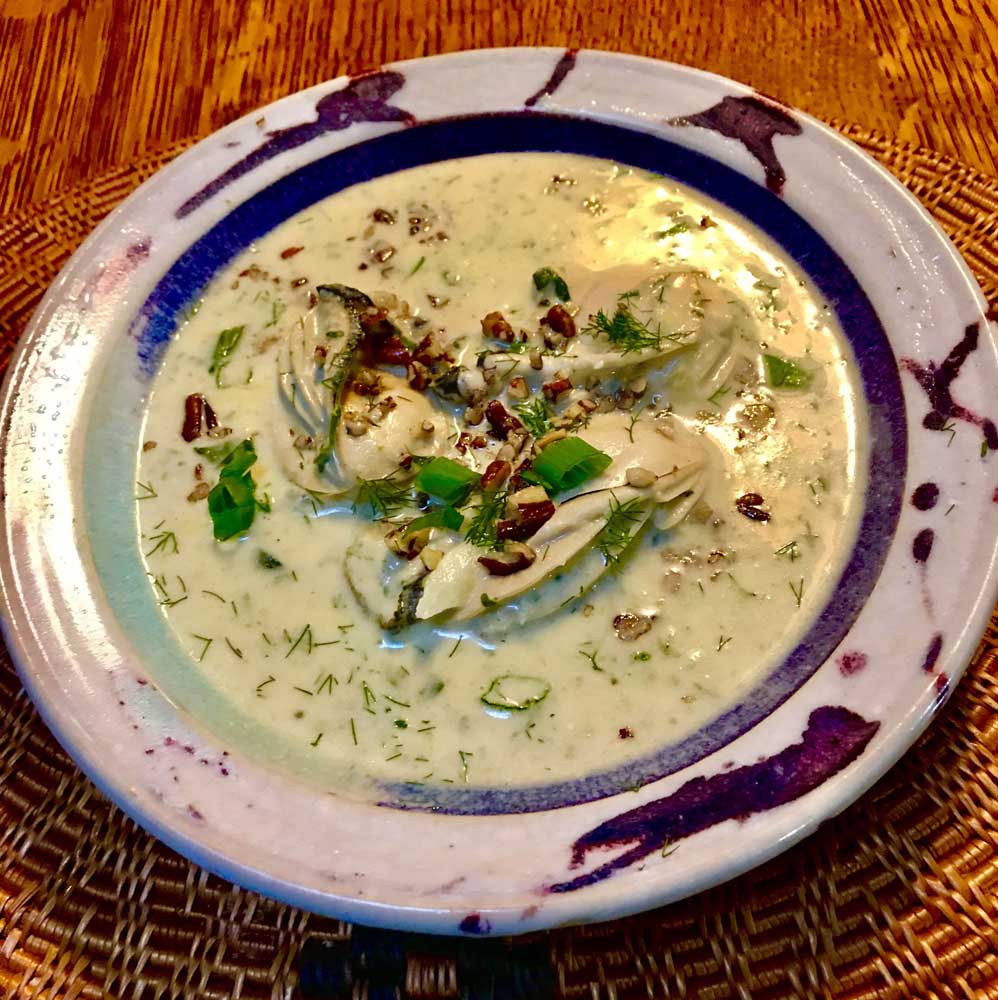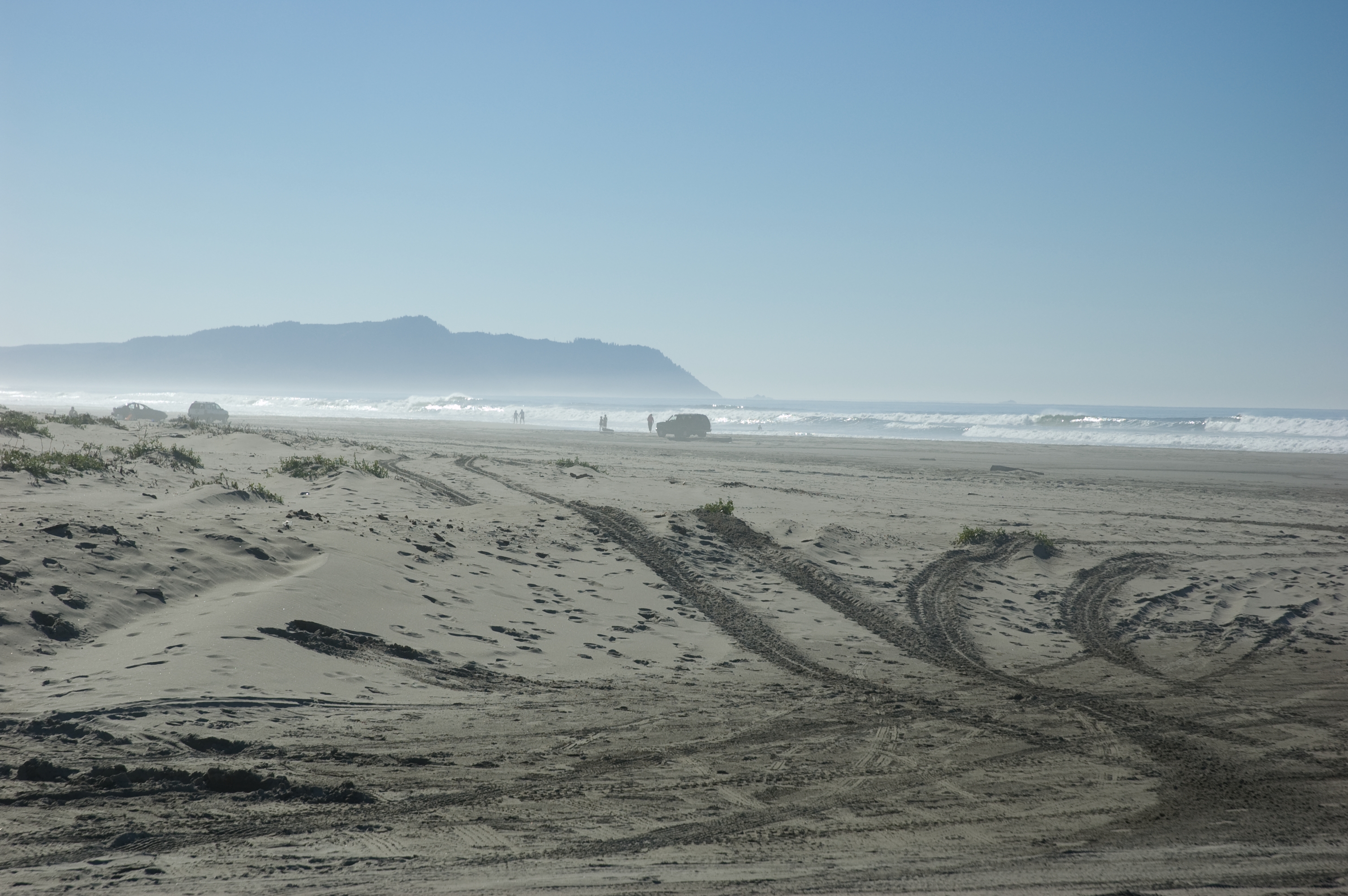Delights of the garden and sea
Published 4:45 am Monday, May 24, 2021

- Pan-fried oysters in an oyster stew.
James Beard taught us that each region in the United States has bragging rights for its own brand of mouth-watering, native foods. Each has a particular style, with distinct products and tastes. Beard, who spent his summers as a teen in Gearhart, particularly loved the Pacific Northwest.
I remember as a young man rappelling down a cliff to the ocean floor and picking a bushel of fresh ocean mussels off a rocky edifice. My wife and me prepared a half-dozen mussel recipes for Beard. The master chef admired the natural abundance.
“There is no bottom, none, to my voluptuousness,” says Shakespeare. In green country abounding with fresh seafood, wild mushrooms and a cornucopia of native plants and berries, the North Coast celebrates both lush and abundant offerings.
Here from the earthly garden of delights are recipes for the four seasons.
Spring
Razor clam chowder
Clams have been an integral part of the Northwest diet since native peoples settled on the Pacific shores thousands of years ago. The flavor and popularity of the clams extended to the first settlers and has remained a favorite. Each spring, thousands of locals and visitors alike flood the beaches of Washington state and the North Coast, seeking the tasty bivalves. Whether fried, ground into fritters or minced into chowders, the opportunities for fine cuisine are endless. And how about razor clam pasta, a favorite in our household. Beard reveled in our fortuitous bounty. And so do we.
Ingredients:
• A limit (15) chopped razor clams diced, or 3 pounds of littleneck clams steamed, liquid reserved.
• 1/4 pound of sliced bacon, fried medium-well, grease strained and reserved for another day.
• Three large potatoes diced into fine (quarter inch) pieces and par-boiled, strained and reserved for chowder.
• 2 cups of diced celery
• One large onion, small diced
• 2 tablespoons of fine minced garlic
• 1/4 cup of flour for roux
• Finely chopped parsley, chives and fennel to your taste (2 tablespoons each). Reserve some for garnish.
• If you use other clams, reserve 3 cup of the stock from the steamed mussels or littlenecks. Some chefs add canned clam juice.
• 3 tablespoons each of butter and olive oil
• 2 cups of cream
• Whole milk or half-and-half to thin the roux. Up to 4 cups.
• 1/2 cup white wine
• Salt to taste
• 1/2 tablespoon of curry paste (optional)
• 2 tablespoons of sherry with each serving (optional)
Sauté onion and garlic in butter and olive oil. Add celery, stirring until translucent, and then add the cooked bacon. Marry in the flour and stir gently and consistently for two to three minutes until you attain a thick smooth roux. A browned roux is less pasty. Slowly pour in the juices and wine, and then the milk and cream. Stir diligently while the sauce thickens. After the sauce has reduced slightly, add the clams and potatoes. Simmer, but do not boil. Boiling toughens the clams. Add half the herbs and reserve the rest as garnish. Salt to taste. Serve in wide-rimmed bowls (with a touch of sherry) and garnish with the remaining herbs and a splash of paprika on the rims. Cornbread is a fine accompaniment.
Summer
Baked salmon with saffron rice and kale
Salmon is health and happiness in the Pacific Northwest. Little else has impacted the lives and of ancient and modern society more than this tasty fish. They remain a favorite among sportsmen. The mouth of the Columbia River is a mecca for fishermen worldwide. In the fall, most of the rivers that feed into the Columbia or the Pacific Ocean are stalked by determined fishers as the fish return to their birthplace on their final voyage.
There are infinite ways to prepare the flesh, but baking remains one of the simpler and more flavorful methods. There is very little fuss. These same fillets can be easily barbecued. Served with corn on the cob and a green salad, few dinners are better received.
Ingredients:
• Four 6 ounce fillets of salmon, silver or king
• 1/4 cups of virgin olive oil
• Kosher salt, salt to your preference
• Fine chopped garlic, three cloves
• Chopped parsley and fennel
This is so simple. Wipe the olive oil around each fillet and save a bit to coat a baking sheet. Sprinkle the salt and fresh chopped herbs over the fillets. Smashed and fine minced garlic adds a nice dimension. Roast only for a few minutes until small white beads of salmon fat rise to the top of the fillets or when the temperature registers at about 145 degrees Fahrenheit. Oven temperature for baking is best around 325 degrees. You can prepare a cream sauce by reducing 2 cups of heavy cream and a half cup of white wine to about half portion, and then adding a tiny pinch of curry paste and chopped fennel to the sauce. Pour the preparation over the salmon and serve immediately. Steamed kale with 2 tablespoons of black bean sauce is a perfect accompaniment. Salt, of course. Par-boiled yellow or Finn potatoes (I grow a heritage Ozette potato in our garden) tossed in an 1/8 teaspoon of turmeric and a healthy splash of olive oil is perfect for rounding out this simple but sublime dinner. Of course, a saffron rice is a perfect substitution, the cat’s meow, so to speak.
Autumn
Steamed mussels with soba noodles and garlic bread
I love mussels. And I adore fresh Japanese soba noodles. Marry them together with nectar from the steamed clams and you are approaching heavenly bliss. Again, this recipe is a simple preparation, and so tasty, served in a large high-rimmed bowl, steaming hot with the most pleasant bouquet.
Ingredients:
• 4 pounds fresh mussels. Penn Cove mussels are clams of perfection.
• 2 cup of dry wine
• 2 tablespoons of butter
• Four fine diced cloves of garlic
• Half an onion, diced
• 2 tablespoons Hoisin sauce
• Sprinkling of red chili flakes
• Four large leaves of kale sliced into 1/4 inch ribbons
• 1 pound of soba noodles, par-boiled
Steam the mussels with the wine, butter, garlic, onion, Hoisin and red chili flakes until the shells spring open. Meanwhile, boil the noodles until al dente and hold, keeping warm. Add the kale at the last minute and continue steaming until the leaves wilt. Place the noodles in the bottom of four large bowls. Arrange kale and the mussels over the top of the noodles and ladle in enough broth to almost cover, leaving the mussels and kale nesting on the top. Serve with a French baguette coated and broiled or baked in a garlic-butter mixture, a cube of butter softened with one heaping tablespoon of fresh minced garlic.
Winter
Pan-fried oysters or oyster stew
Oh! The sublime oyster. This is a bivalve best eaten in the cold winter months. Willapa Bay in southwest Washington state is a major home of these shellfish. Over 20% of these creatures devoured in our nation come from the pristine waters of Willapa Bay. They also grow in abundance along the Oregon Coast. Consumed on the half-shell, raw oysters are prized by millions. They need nothing else to be eaten au natural, although many of their devotees dribble a bit of melted butter over the tops or even a ketchup-horseradish mixture. A piquant sauce mignonette remains a chef’s favorite.
Pan fried in a triple dip of flour (first), beaten egg (second) and finally cracker crumbs or panko, the soft flesh pleases the palette like the best of seafoods. Oyster appreciation is a love-hate relationship. But, I swear, follow this recipe and you can’t help but appreciate the briny, butter-cream taste, and yes, the rusty copper aftertaste that follows.
Ingredients:
• 24 fresh, small oysters
• 1 cup crushed pecans
• 1 onion, diced small
• 4 ounces butter
• 2 cups chopped spinach
• 2 cups chicken stock
• 2 cups milk
• 2 cup heavy cream
• Chives
Sauté the onion and pecans in 2 tablespoons of butter with a drizzle of virgin olive oil. Add the liquids and slow cook for 10 minutes. Add the spinach. Add the oysters quickly and evenly. Do not boil, but simmer for a few minutes. Serve immediately in generous bowls with a garnish of chopped chives and a pat of butter. Some folks like a bit of Tabasco. A tablespoon of good scotch can be a crowd pleaser but follow your own taste. Cornbread is a lovely accompaniment. Gewurztraminer or pinot gris matches the dish perfectly. The dish is wonderful, served on a cold winter night.
***
The Pacific Northwest has so much to offer. This article doesn’t even touch on the pleasures of a plate of wild mushrooms sauteed in butter and garlic and finished with reduced cream and stock. Over pasta, the fungi are simply unsurpassed.
If you are hunter, duck and geese and deer abound. These are the wild things, and the tastes are unsurpassed. Dungeness crab is a class-favorite. Whether simply extracted from the crusty red shells, or married in any number of sauces, fried rice or enhanced with a delicate Mornay sauce, the delicate sweet meat continues to be prized. The crab industry is a major employer in Astoria and Ilwaco, Washington. Crabbers risk their lives during the winter storms to capture the crustaceans. Some of these same fishers also comb the ocean for a dozen brands of whitefish from albacore tuna to seabass.









